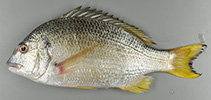| Family: |
Sparidae (Porgies) |
| Max. size: |
45 cm TL (male/unsexed); max.weight: 2,000.0 g |
| Environment: |
pelagic-neritic; marine |
| Distribution: |
Eastern Indian Ocean: north-western Australia. |
| Diagnosis: |
Dorsal spines (total): 11-11; Dorsal soft rays (total): 10-12; Anal spines: 3-3; Anal soft rays: 8-8. This species is distinguished from its congeners by the following set of characters: moderately deep body, 2.0-2.4 (mean 2·2) times in SL: D XI,11 (rarely XI,10); first soft dorsal-fin ray slightly longer than last dorsal-fin spine; scale rows between fifth dorsal-fin spine base and lateral line 3.5 ; scale rows above lateral line 4.5, scale rows below 11.5; short second anal-fin spine, ordinary [16.7-.20.7% (mean 18.4%) of SL], 1.1-1.3 (mean 1.2) in 2AS/3AS; pored lateral-line scales 42-45 (mode 44); pelvic, anal and caudal fins entirely vivid yellow, caudal fin with a wide black posterior margin; absence of black streaks proximally near anal-fin base on inter-radial membranes between yellow anal-fin rays; black blotches on inter-radial membranes between dorsal-fin rays absent; weak diffuse dark blotch at origin of lateral line (usually covering first pored lateral line scale) continuing as relatively black pigment over upper rear part of opercle (Ref. 93743). |
| Biology: |
Occurs in shallow coastal waters and enters river mouths and estuaries. Schooling species; often feeds on tidal flats. A popular angling species, often caught with hook and line and sometimes taken by trawlers (Ref. 44894). |
| IUCN Red List Status: |
Least Concern (LC); Date assessed: 17 March 2014 Ref. (130435)
|
| Threat to humans: |
harmless |
Source and more info: www.fishbase.org. For personal, classroom, and other internal use only. Not for publication.

